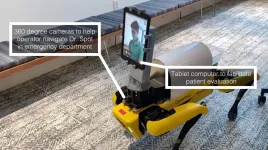(Press-News.org) CAMBRIDGE, MA -- In the era of social distancing, using robots for some health care interactions is a promising way to reduce in-person contact between health care workers and sick patients. However, a key question that needs to be answered is how patients will react to a robot entering the exam room.
Researchers from MIT and Brigham and Women's Hospital recently set out to answer that question. In a study performed in the emergency department at Brigham and Women's, the team found that a large majority of patients reported that interacting with a health care provider via a video screen mounted on a robot was similar to an in-person interaction with a health care worker.
"We're actively working on robots that can help provide care to maximize the safety of both the patient and the health care workforce. The results of this study give us some confidence that people are ready and willing to engage with us on those fronts," says Giovanni Traverso, an MIT assistant professor of mechanical engineering, a gastroenterologist at Brigham and Women's Hospital, and the senior author of the study.
In a larger online survey conducted nationwide, the researchers also found that a majority of respondents were open to having robots not only assist with patient triage but also perform minor procedures such as taking a nose swab.
Peter Chai, an assistant professor of emergency medicine at Brigham and Women's Hospital and a research affiliate in Traverso's lab, is the lead author of the study, which appears today in JAMA Network Open.
Triage by robot
After the Covid-19 pandemic began early last year, Traverso and his colleagues turned their attention toward new strategies to minimize interactions between potentially sick patients and health care workers. To that end, they worked with Boston Dynamics to create a mobile robot that could interact with patients as they waited in the emergency department. The robots were equipped with sensors that allow them to measure vital signs, including skin temperature, breathing rate, pulse rate, and blood oxygen saturation. The robots also carried an iPad that allowed for remote video communication with a health care provider.
This kind of robot could reduce health care workers' risk of exposure to Covid-19 and help to conserve the personal protective equipment that is needed for each interaction. However, the question still remained whether patients would be receptive to this type of interaction.
"Often as engineers, we think about different solutions, but sometimes they may not be adopted because people are not fully accepting of them," Traverso says. "So, in this study we were trying to tease that out and understand if the population is receptive to a solution like this one."
The researchers first conducted a nationwide survey of about 1,000 people, working with a market research company called YouGov. They asked questions regarding the acceptability of robots in health care, including whether people would be comfortable with robots performing not only triage but also other tasks such as performing nasal swabs, inserting a catheter, or turning a patient over in bed. On average, the respondents stated that they were open to these types of interactions.
The researchers then tested one of their robots in the emergency department at Brigham and Women's Hospital last spring, when Covid-19 cases were surging in Massachusetts. Fifty-one patients were approached in the waiting room or a triage tent and asked if they would be willing to participate in the study, and 41 agreed. These patients were interviewed about their symptoms via video connection, using an iPad carried by a quadruped, dog-like robot developed by Boston Dynamics. More than 90 percent of the participants reported that they were satisfied with the robotic system.
"For the purposes of gathering quick triage information, the patients found the experience to be similar to what they would have experienced talking to a person," Chai says.
Robotic assistants
The numbers from the study suggest that it could be worthwhile to try to develop robots that can perform procedures that currently require a lot of human effort, such as turning a patient over in bed, the researchers say. Turning Covid-19 patients onto their stomachs, also known as "proning," has been shown to boost their blood oxygen levels and make breathing easier. Currently the process requires several people to perform. Administering Covid-19 tests is another task that requires a lot of time and effort from health care workers, who could be deployed for other tasks if robots could help perform swabs.
"Surprisingly, people were pretty accepting of the idea of having a robot do a nasal swab, which suggests that potential engineering efforts could go into thinking about building some of these systems," Chai says.
The MIT team is continuing to develop sensors that can obtain vital sign data from patients remotely, and they are working on integrating these systems into smaller robots that could operate in a variety of environments, such as field hospitals or ambulances.
INFORMATION:
Other authors of the paper include Farah Dadabhoy, Hen-wei Huang, Jacqueline Chu, Annie Feng, Hien Le, Joy Collins, Marco da Silva, Marc Raibert, Chin Hur, and Edward Boyer. The research was funded by the National Institutes of Health, the Hans and Mavis Lopater Psychosocial Foundation, e-ink corporation, the Karl Van Tassel (1925) Career Development Professorship, MIT's Department of Mechanical Engineering, and the Brigham and Women's Hospital Division of Gastroenterology.
How governments and companies should listen to the people on climate change
People are more engaged in reducing carbon emissions than previously thought - and governments, scientists and companies should listen to them - according to new research from the University of East Anglia and the UK Energy Research Centre.
A new study published today in Nature Energyy investigates how invested people are in making the changes needed to reduce carbon emissions and stop climate change.
The study shows that people, their views and actions should be included more when it comes to how we transform the way we use energy, to keep global average temperatures well below 2°C as set out in the Paris COP21 climate agreement.
Lead ...
HOUSTON -- Contrary to long-held beliefs, Type I collagen produced by cancer-associated fibroblasts may not promote cancer development but instead plays a protective role in controlling pancreatic cancer progression, reports a new study from researchers at The University of Texas MD Anderson Cancer Center. This new understanding supports novel therapeutic approaches that bolster collagen rather than suppress it.
The study finds that collagen works in the tumor microenvironment to stop the production of immune signals, called chemokines, that lead to suppression of the anti-tumor immune response. When collagen is lost, chemokine levels increase, and the cancer is allowed ...
Digital solutions including remote monitoring can help chronic pain sufferers manage their pain and reduce the probability of misuse of prescription opioids.
For chronic pain sufferers an app may be just the tool they need to manage their pain. In a UHN-led study that used the app "Manage My Pain" enrolled patients saw clinically significant reductions in key areas that drive increased medical needs, potential abuse of prescription opioids and of course, pain.
Toronto (March 4, 2021) - For the first time, an app has been shown to reduce key symptoms of chronic pain. A UHN-led study evaluated the impact of Manage My Pain (MMP), a digital health solution developed ...
The body's immune response plays a crucial role in the course of a SARS-CoV-2 infection. In addition to antibodies, the so-called T-killer cells, are also responsible for detecting viruses in the body and eliminating them. Scientists from the CeMM Research Center for Molecular Medicine of the Austrian Academy of Sciences and the Medical University of Vienna have now shown that SARS-CoV-2 can make itself unrecognizable to the immune response by T-killer cells through mutations. The findings of the research groups of Andreas Bergthaler, Judith Aberle and Johannes Huppa provide important clues for the further development of vaccines and were published in the journal Science ...
A recent study outlines a range of privacy concerns related to the programs that users interact with when using Amazon's voice-activated assistant, Alexa. Issues range from misleading privacy policies to the ability of third-parties to change the code of their programs after receiving Amazon approval.
"When people use Alexa to play games or seek information, they often think they're interacting only with Amazon," says Anupam Das, co-author of the paper and an assistant professor of computer science at North Carolina State University. "But a lot of the applications they are interacting with were created by third parties, and we've identified several flaws in the current vetting process that could allow those third parties to gain access to users' personal or private ...
Cervical cancer is a serious global health threat which kills more than 300,000 women every year. It's a disease that disproportionately affects women in low- and middle-income countries in equatorial Africa, Latin America and Southeast Asia, yet it is a preventable disease and decades of research have produced the tools needed to eliminate it.
Recognizing this urgent public health issue, the editorial team of Preventive Medicine, led by Editor-in-Chief Dr. Eduardo Franco, Director, Division of Cancer Epidemiology and Chair, Gerald Bronfman Department ...
Researchers in Japan have developed the first wearable devices to precisely monitor jaundice, a yellowing of the skin caused by elevated bilirubin levels in the blood that can cause severe medical conditions in newborns. Jaundice can be treated easily by irradiating the infant with blue light that breaks bilirubin down to be excreted through urine. The treatment itself, however, can disrupt bonding time, cause dehydration and increase the risks of allergic diseases. Neonatal jaundice is one of the leading causes of death and brain damage in infants in low- and middle-income countries.
To address the tricky balance ...
On Earth, plate tectonics is not only responsible for the rise of mountains and earthquakes. It is also an essential part of the cycle that brings material from the planet's interior to the surface and the atmosphere, and then transports it back beneath the Earth's crust. Tectonics thus has a vital influence on the conditions that ultimately make Earth habitable.
Until now, researchers have found no evidence of global tectonic activity on planets outside our solar system. A team of researchers led by Tobias Meier from the Center for Space and Habitability (CSH) at the University of Bern and with the participation of ETH Zurich, the University of Oxford and the National Center of Competence in Research NCCR PlanetS has now found evidence of the flow patterns inside ...
Female gannets travel further than male gannets to find fish for their chicks in some years but not others, new research shows.
Scientists tracked breeding gannets from Grassholm Island in Wales over 11 years with tiny GPS devices and by measuring isotopic signatures in their blood.
Male gannets flew an average of 220km to forage for their chicks, while females averaged 260km. Some birds travelled 1,000km on a single trip.
The scientists also found that the two sexes selected different habitats and foraged at different times of day, but some years ...
COLUMBUS, Ohio - Putting a price on producing carbon is the cheapest, most efficient policy change legislators can make to reduce emissions that cause climate change, new research suggests.
The case study, published recently in the journal Current Sustainable/Renewable Energy Reports, analyzed the costs and effects that a variety of policy changes would have on reducing carbon dioxide emissions from electricity generation in Texas and found that adding a price, based on the cost of climate change, to carbon was the most effective.
"If the goal is reducing carbon dioxide in the atmosphere, what we found is that putting a price on carbon and then letting suppliers and consumers make their ...






